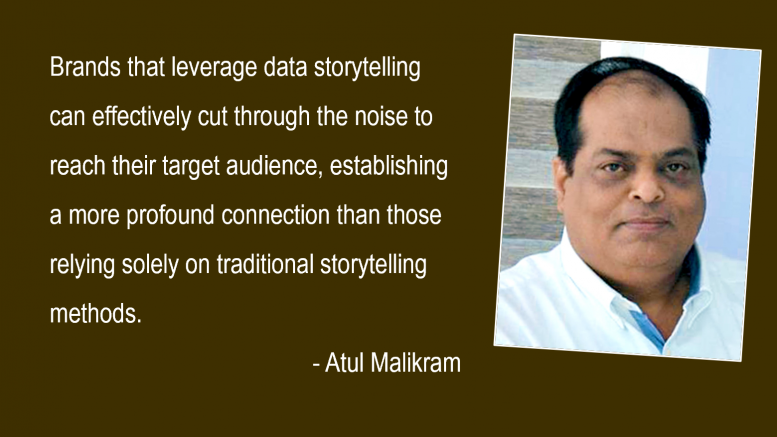In the fast-paced world of modern marketing, storytelling has evolved beyond traditional boundaries. Brands continuously explore innovative ways to connect with their audiences, recognising that understanding consumer interests, behavior, and motivations is paramount in creating a meaningful connection. In this digital age, the key to wielding the magic wand of effective storytelling lies in the strategic use of data—transforming raw information into actionable insights that resonate intimately and on a long-term scale.
The Power of Data in Modern Storytelling
In the realm of Public Relations, the adage “the story you’re selling is only as good as the data that backs it” holds true in today’s marketing landscape. While words can craft compelling narratives, numbers speak louder and provide the concrete foundation necessary to make stories real. Successful marketing stories encompass a hook that captures attention, a narrative that maintains interest, and numbers that substantiate the story’s authenticity.
Great brand stories don’t just happen; they are carefully constructed through a fusion of creativity and data-driven decision-making. Brands that leverage data storytelling can effectively cut through the noise to reach their target audience, establishing a more profound connection than those relying solely on traditional storytelling methods.
The Role of Listening and Processing in Narrative Data
As a PR maestro, you need to appreciate the importance of listening to consumers. However, making sense of the narrative data generated is equally vital. Processing and analysing conversations from diverse sources enable a deeper understanding of strategic narratives that resonate with the audience.
Linking narrative performance data to business metrics provides further clarity. By examining how narrative engagement influences funnel conversion rates, website traffic, sales, and other key performance indicators (KPIs), brands gain actionable intelligence that guides future campaigns.
Data-Driven Brand Narratives
Data storytelling is an intricate dance that requires meticulous collection and analysis of diverse data sources. In the world of PR, surveys, social media analytics, website metrics, customer feedback, testimonials, user-generated content, market research, and competitor analysis all contribute to building a comprehensive view for impactful brand storytelling. Let’s take a moment to applaud brands that have mastered the art of data-driven brand narratives:
Zomato – Recently, while wishing a Happy New Year, Zomato CEO Deepinder Goyal shared a compelling statistic about the generosity of Indians on New Year’s Eve, tipping delivery partners a total exceeding Rs 97 lakhs. This real-time data point not only reflects consumer behavior but also becomes a part of Zomato’s brand story.
Google – A powerhouse of data, showcases its mastery in data storytelling through the annual “Year in Search.” This compilation evokes a range of emotions by encompassing stories that resonated with the audience, as reflected in their search queries throughout the year.
Airbnb – Exemplifies the fusion of nuanced understanding and creative use of consumer data in its marketing campaigns. The brand’s identity revolves around community and local hospitality, tapping into the desire for more personalised travel experiences. Airbnb’s content marketing employs both general and specific data-driven stories, providing insights into optimal locations for hosts and predicting success based on property features and pricing.
Spotify – A leader in the streaming service domain, Spotify has demonstrated the power of data in its continuous growth. Reporting a 40% year-on-year growth in ad revenue in Q4 2021 and doubling usage since 2017, Spotify’s success lies in its ability to leverage data for both strategic decision-making and captivating storytelling.
Amazon – Amazon’s dominance in the e-commerce landscape is not solely attributed to its extensive product selection or efficient logistics network. Rather, it is their relentless focus on understanding and harnessing the power of data that sets them apart. By employing sophisticated data analytics techniques and cutting-edge technologies, Amazon transforms raw data into valuable insights that fuel their operations, marketing strategies, and customer-centric approach.
In the realm of public relations, data storytelling has become an indispensable tool for building a robust brand identity and driving successful marketing campaigns. By understanding and leveraging audience data, brands can create narratives that not only resonate but also foster long-term connections. As a PR specialist, it is important to be well-aware of the synergy between compelling stories and data-driven insights, allowing brands to cut through the noise and deliver impactful messages that leave an indelible mark on their audience. In an era where numbers speak louder than words, data emerges as the linchpin for crafting narratives that not only stand out but also resonate in the fiercely competitive landscape of modern PR. So, go ahead, wield the power of data, and let your brand narratives captivate the world.
The views and opinions published here belong to the author and do not necessarily reflect the views and opinions of the publisher.



Be the first to comment on "Magic of Numbers: How Data Shapes Brand Narratives"